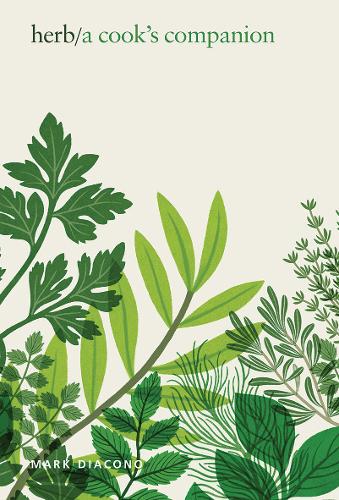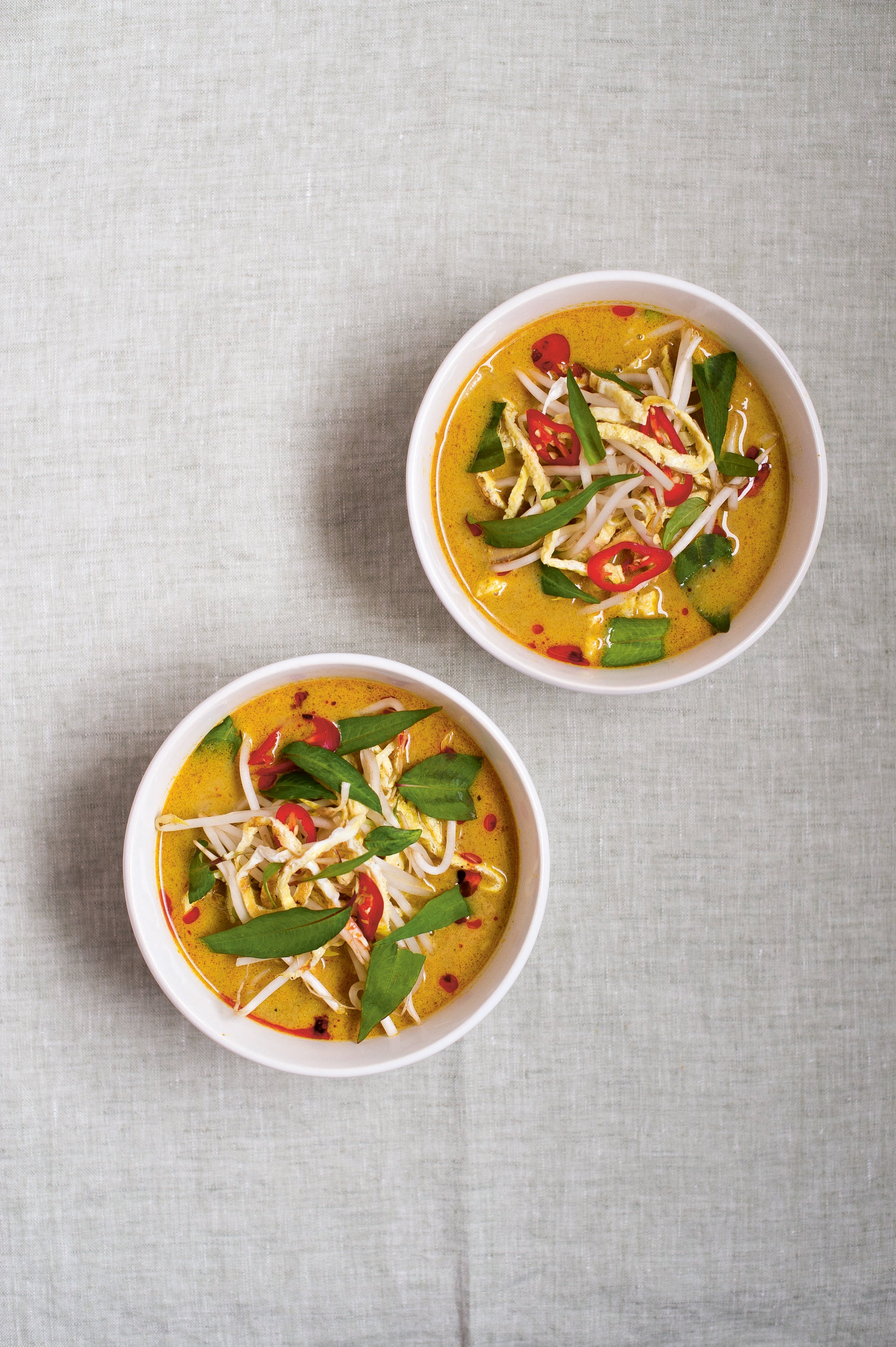The Independent's journalism is supported by our readers. When you purchase through links on our site, we may earn commission.
We’ve been using herbs all wrong. Here’s three recipes that get it right
Expert gardener and food writer Mark Diacono’s new cookbook is dedicated to the humble herb. And so far, we haven’t been doing them justice, finds Ella Walker

We don’t need herbs,” says Mark Diacono, a man who has just written an entire cookbook about them. He goes on to call them “unnecessary” and adds, quite heartlessly, that “we can perfectly merrily eat for the rest of our lives without herbs and we will live”.
However, they are also “the thing that makes the difference between feeding and eating,” he says, turning this dark tale into a light-filled parable. “It’s the unnecessary brilliance of [using herbs] that just makes you want to eat this delightful thing and get pleasure from it.”
And so, in conclusion, we actually do very much need herbs on our plates and growing windowsills, and Diacono, food writer, photographer and creator of Otter Farm – a nursery designed to encourage people to grow “unusual and forgotten food” – is very willing to share his affection for herbs.
“We’re the only species on earth that cooks,” he continues. “We’re doing it for two reasons. One is to transform foods into something that’s edible, you know, just plain old ‘I can eat that/That’s not going to kill me and/or I’m not going to lose my teeth trying to get through it’. But once you’ve got to that point, the rest really is about pleasure.”
Herbs provide “that little tweak” that can amp up a dish or morph its character slightly – take Diacono’s bread and butter pudding. Laced with standard thyme he says it takes on a “Novemberish” feel, whereas lemon thyme connotes April.
Despite his adoration for most of them, Diacono does not indiscriminately enjoy all edible shoots. In Herb: A Cook’s Companion, the follow-up to his 2019 cookbook, Sour, he rages amiably at the ubiquitous one leaf of parsley garnish (“It’s, ‘I thought about you, but I didn’t think about you enough…’”) and rails at being presented with whole mint leaves to eat (“They’re just unpleasant in the mouth”).

Poor lemon balm feels the full brunt of his ire. “I love it in the garden; in the kitchen, I couldn’t be less interested,” he explains. “There’s no meal that can be improved by lemon balm, there’s no delight to be had from it.” According to Diacono, it’s the sherbet leaves of lemon verbena you really ought to look for.
The problem is, most of us get “stuck” with the herbs that we use. Diacono nods to the usual suspects, mint, coriander, rosemary, thyme and parsley – which in a double-whammy of going through the motions, as we also tend to use them repeatedly in the same old ways. It means we’re accessing only a “tiny little sliver” of the green fronds we could be scoffing.
“If you get to grips with herbs just a little – and they’re very easy to get to grips with – then it could change your food like nothing else,” says Diacono. “These are the clothes that dress up the plainer ingredients. You’re in for a fair bit of fun with them.”
Pairing them in different combinations, or c“We tend to only have a certain amount of time and space that we can dedicate to growing stuff,” he says, “so make it the flavours you cannot have unless you grow it yourself.”hucking them into dishes at varied moments during cooking could make a real impact, he reckons. For instance, when making mint sauce, Diacono doubles the mint; dousing the bulk of it in water, sugar and vinegar, and then topping it with finely shredded fresh before serving for extra zing.
Another swift way to up your herb game is to consider how you’re wielding your knife. “How we chop is really important,” says Diacono, calling it an ingredient in its own right. “If we leave the chop fairly coarse, what you get is a punch every now and again, of say, coriander – it becomes a surprise: ‘Oh, that was coriander!’ rather than if we chop it really finely and throw it in, everything becomes coriander. The impression is very different.”

He considers herbs a way to build, season and layer flavour, and fortunately, “it’s quite hard to overuse a herb I would say, so play, experiment and keep tasting – people tend to taste right at the end, keep tasting, keep tasting.”
Diacono is a hugely successful gardener – he writes gardening books as well as recipes – so it’s massively reassuring to know how relaxed he is about stuffing bundles of parsley guilt-free in the supermarket trolley.
“My belief is, buy the herbs you use masses of. There’s just no way, unless you have infinite time and space, that you can grow all the parsley, all the coriander, all the thyme you are likely to use if you like it,” he says. “You’ll end up hammering the thyme plant to death.”
The ones you should consider sowing and growing from seed at home, he says “are the embellishments on that”. He’s talking ginger rosemary, orange thyme, pineapple sage, Vietnamese coriander, the “varieties on the variety”, as well as the leaves you’d just struggle to buy, like shiso, salad burnet, chervil, savory.
“We tend to only have a certain amount of time and space that we can dedicate to growing stuff,” he says, “so make it the flavours you cannot have unless you grow it yourself.”
Read more:
Even a few pots by the back door, he’s adamant, “can transform every meal you eat. That’s a pretty extraordinary thing and it’s very easy to achieve.”
He’s all for just giving things a go, be it making marjoram and chive flower salt, distilling the essence of fig leaves in syrup, or infusing all the vodka he can get his hands on, apothecary-like, with twirled stems of lovage and stalks of lemongrass.
“We are desperate to just do the things we’re good at,” he muses. “So we tend to shut down [when faced with new challenges]. We tend to do fewer and fewer things. We just do the things we’re good at. We defend them with a cricket bat, you know, and it’s like: stop it, we’re here to live for a very short time, do stuff you’re crap at and get good at it, if you want to, or just be crap at it! It doesn’t matter.
“We’re here to live,” he continues – and even the smallest jot of greenery can help us remember that it’s the small things, be it a furry leaf of sage rubbed between your fingers, or chewing on a homegrown sorrel leaf. “I think we mustn’t lose that sense of play. We mustn’t lose that sense of doing things. Of joy.”
Laksa

The star of this spectacular soup is laksa leaf, aka Vietnamese coriander, with its creamy, bright, lemony coriander flavour. Mint and coriander in a 1:2 ratio works differently well. Don’t be put off by the lengthy list of ingredients: it is as simple in creation as it is delicious.
Makes: 4 servings
Ingredients
3 tbsp sunflower
200ml coconut milk
30g tamarind paste
1 tsp shrimp paste (or use 1 tbsp fish sauce)
1 tbsp palm sugar (or use soft light brown sugar)
800ml chicken stock or water
100g chicken, diced pinch of salt
2 medium eggs, beaten
150g dried rice vermicelli or 2 portions of pre-cooked noodles
150g raw prawns
300g beansprouts, or cucumber cut into matchsticks
1 bunch of spring onions, finely chopped
1 lime, ½ juiced and ½ cut into wedges
25g bunch of Vietnamese coriander
Sambal, chilli oil or sliced red chilli, to serve
For the paste:
1 large shallot, chopped
3 garlic cloves, chopped
1 tbsp grated fresh ginger
1 lemongrass stalk, chopped
30g roasted peanuts or cashews
½ tsp sea salt
2 tsp chilli flakes
2 tsp ground cumin
1½ tsp ground coriander
½ tsp ground star anise
¼ tsp ground cloves
¼ tsp grated nutmeg
¼ tsp ground cardamon
Method
1. First make the paste. Blitz the shallot, garlic, ginger, lemongrass, nuts, 100ml water, salt and the spices in a food processor until smooth (add an extra splash of water if needed).
2. Heat two tablespoons of the oil in a large pan, add the paste and fry for five to 10 minutes, or until all the water has evaporated and the paste is starting to brown and stick to the bottom of the pan.
3. Stir the coconut milk, tamarind paste, shrimp paste or fish sauce, sugar and the stock into the paste, then bring to the boil. Add the chicken and simmer for 15-20 minutes until the chicken is cooked.
4. While the chicken is cooking, add the salt to the eggs and fry in the remaining oil in a small frying pan to form a thin omelette. Flip and cook on the other side, then remove from the pan and allow to cool. Roll up the omelette into a cigar shape and cut into thin strips.
5. Cook or soak the noodles as per the packet instructions, drain and divide between four bowls.
6. Add the prawns to the laksa and simmer for around three minutes until just cooked through. Add the beansprouts, spring onions and lime juice. Top the noodles with the sliced omelette and a couple of ladles of laksa. Serve topped with roughly chopped coriander and a drizzle of the sambal or chilli oil, and lime wedges on the side.
Dill, lemon and green bean pilaf recipe

It’s usually at about the sixth attempt that I finally stop my fork pecking at a plate of this. It is crazily moreish. By all means, make this with coriander, mint, lovage or chervil in any combination, but this is one of the places I love dill, and plenty of it. Whichever herbs you choose, go big.
Makes: 4-6 servings
Ingredients
300g basmati rice
400ml chicken or vegetable stock
30g butter
1 onion, thinly sliced
3 garlic cloves, finely chopped
2 bay leaves
Big bunch of dill, stalks and leaves separated and both finely chopped
1 tsp ground cumin
1 tsp ground coriander
½ tsp ground turmeric
¼ tsp ground cinnamon
200g green beans, stalk end trimmed (or use thin slices of courgette)
Finely grated zest of 1 unwaxed lemon
40g shelled pistachios (or use whole almonds), roughly chopped
Sea salt and freshly ground black pepper
Natural yoghurt and lemon wedges, to serve
Method
1. Soak the rice in a bowl of cold water for 10 minutes, then drain well. Bring the stock to a bare simmer.
2. Melt the butter in a wide pan over a low-medium heat and cook the onion, garlic, bay leaves and dill stalks for 10 minutes until soft. Add the spices and half a teaspoon salt and cook for a minute.
3. Add the rice to the pan, along with the beans and half of the dill leaves, stirring for 30 seconds to coat well and so it doesn’t burn. Cover the rice with the hot stock, add the lemon zest and check the seasoning, adding salt and pepper to taste. Put the lid on and cook for five minutes over a high heat, then turn it down to the lowest heat and cook for 10 minutes until the stock is absorbed and the rice is just tender. Turn the heat off, remove the lid and place a tea towel over the pan, then return the lid and leave to rest for five minutes.
4. Fluff the rice with a fork, then scatter over the remaining dill and the nuts and serve immediately with yoghurt and lemon wedges on the side.
Rosemary and basil aubergines in za’atar recipe

This is Diacono’s favourite way with aubergines, and one that shows how they take beautifully to so many herbs.
The oregano in the za’atar and the rosemary lend flavour to the cooking aubergines, while the fresh basil scattered to serve completes the picture. Adding the rosemary for the last few minutes aromatises the aubergines; I know “aromatise” sounds like the sort of unwelcome thing a garage unexpectedly does to your car when you’ve taken it for an MOT, but I promise it is the best word for it.
It is as if resinous smoke has been blown through every pore of the aubergine, without a trace of the bitterness that comes with roasting rosemary sprigs until they resemble the skeletons of sparrows’ legs. Try this with roast lamb, griddled courgettes, couscous and pretty much any cold cuts.
Makes: 4 servings
Ingredients
4 aubergines, quartered lengthways
4 tbsp olive oil
A few good sprigs of rosemary, broken into 3cm pieces
4 tbsp za’atar (see below)
Sea salt and freshly ground black pepper
For the za’atar (makes a small jarful):
3 tbsp sesame seeds
1½ tbsp ground cumin
2 tbsp sumac
2 tbsp dried Mexican oregano, dried marjoram, oregano, savory or hyssop
1 tbsp salt
For the dressing:
50g tahini
1 tbsp yoghurt
Juice of 1 lemon
2 garlic cloves, finely chopped
2 tbsp olive oil
To serve:
Pomegranate molasses
Hot sauce or chilli flakes
Handful of Greek basil leaves, or other basil finely shredded
Method
1. Make the za’atar. Lightly toast the sesame seeds in a pan over a medium heat, shuffling them around a bit to ensure they don’t turn too dark. Combine all the ingredients together with a mortar and pestle, as much as anything to encourage the flavours and scents to be released as they mix. Store in a sealed jar, where it will keep for a few months, losing intensity over time.
2. Preheat the oven to 200C/400F/gas mark 6.
3. Lay the aubergine quarters in a single layer on baking sheets, brush with oil, and sprinkle with salt and pepper. Place in the oven, turn the heat down to 180C/350F/gas mark 4, and cook for 20-25 minutes until tender and brown.
4. Make the dressing by whisking all the ingredients together with two tablespoons water; use a little more water if required, to reach a consistency of double (heavy) cream.
5. Mix the rosemary, za’atar and a heavy grinding of pepper in a bowl. Remove the aubergines from the oven, top with the za’atar mix, drizzle with more oil and return to the oven for five minutes.
6. Drizzle with the tahini dressing, pomegranate molasses, hot sauce or chilli flakes and scatter with basil.
‘Herb: A Cook’s Companion’ by Mark Diacono (Quadrille, £26; photography by Mark Diacono) is available now.
Join our commenting forum
Join thought-provoking conversations, follow other Independent readers and see their replies
Comments